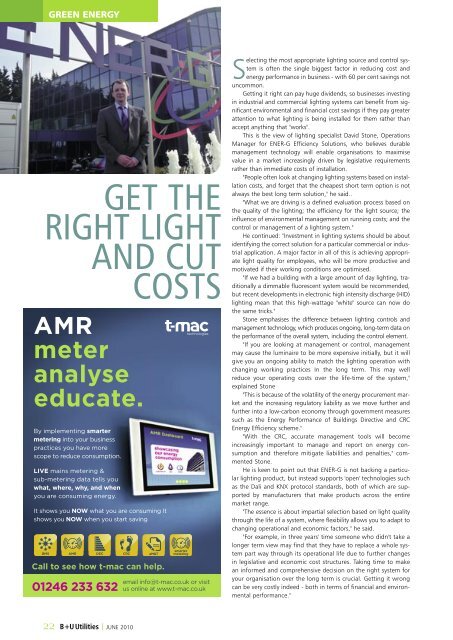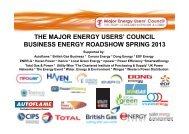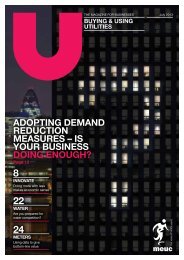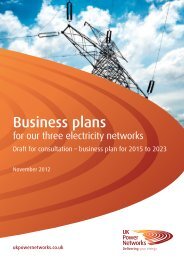CRC - MEUC
CRC - MEUC
CRC - MEUC
You also want an ePaper? Increase the reach of your titles
YUMPU automatically turns print PDFs into web optimized ePapers that Google loves.
GREEN ENERGY<br />
GET THE<br />
RIGHT LIGHT<br />
AND CUT<br />
COSTS<br />
AMR<br />
meter<br />
analyse<br />
educate.<br />
By implementing smarter<br />
metering into your business<br />
practices you have more<br />
scope to reduce consumption.<br />
LIVE mains metering &<br />
sub-metering data tells you<br />
what, where, why, and when<br />
you are consuming energy.<br />
It shows you NOW what you are consuming It<br />
shows you NOW when you start saving<br />
Call to see how t-mac can help.<br />
01246 233 632<br />
22 B+U Utilities | JUNE 2010<br />
email info@t-mac.co.uk or visit<br />
us online at www.t-mac.co.uk<br />
Selecting the most appropriate lighting source and control system<br />
is often the single biggest factor in reducing cost and<br />
energy performance in business - with 60 per cent savings not<br />
uncommon.<br />
Getting it right can pay huge dividends, so businesses investing<br />
in industrial and commercial lighting systems can benefit from significant<br />
environmental and financial cost savings if they pay greater<br />
attention to what lighting is being installed for them rather than<br />
accept anything that "works".<br />
This is the view of lighting specialist David Stone, Operations<br />
Manager for ENER-G Efficiency Solutions, who believes durable<br />
management technology will enable organisations to maximise<br />
value in a market increasingly driven by legislative requirements<br />
rather than immediate costs of installation.<br />
"People often look at changing lighting systems based on installation<br />
costs, and forget that the cheapest short term option is not<br />
always the best long term solution," he said..<br />
"What we are driving is a defined evaluation process based on<br />
the quality of the lighting; the efficiency for the light source; the<br />
influence of environmental management on running costs; and the<br />
control or management of a lighting system."<br />
He continued: "Investment in lighting systems should be about<br />
identifying the correct solution for a particular commercial or industrial<br />
application. A major factor in all of this is achieving appropriate<br />
light quality for employees, who will be more productive and<br />
motivated if their working conditions are optimised.<br />
"If we had a building with a large amount of day lighting, traditionally<br />
a dimmable fluorescent system would be recommended,<br />
but recent developments in electronic high intensity discharge (HID)<br />
lighting mean that this high-wattage "white" source can now do<br />
the same tricks."<br />
Stone emphasises the difference between lighting controls and<br />
management technology, which produces ongoing, long-term data on<br />
the performance of the overall system, including the control element.<br />
"If you are looking at management or control, management<br />
may cause the luminaire to be more expensive initially, but it will<br />
give you an ongoing ability to match the lighting operation with<br />
changing working practices In the long term. This may well<br />
reduce your operating costs over the life-time of the system,"<br />
explained Stone<br />
"This is because of the volatility of the energy procurement market<br />
and the increasing regulatory liability as we move further and<br />
further into a low-carbon economy through government measures<br />
such as the Energy Performance of Buildings Directive and <strong>CRC</strong><br />
Energy Efficiency scheme."<br />
"With the <strong>CRC</strong>, accurate management tools will become<br />
increasingly important to manage and report on energy consumption<br />
and therefore mitigate liabilities and penalties," commented<br />
Stone.<br />
He is keen to point out that ENER-G is not backing a particular<br />
lighting product, but instead supports 'open' technologies such<br />
as the Dali and KNX protocol standards, both of which are supported<br />
by manufacturers that make products across the entire<br />
market range.<br />
"The essence is about impartial selection based on light quality<br />
through the life of a system, where flexibility allows you to adapt to<br />
changing operational and economic factors," he said.<br />
"For example, in three years' time someone who didn't take a<br />
longer term view may find that they have to replace a whole system<br />
part way through its operational life due to further changes<br />
in legislative and economic cost structures. Taking time to make<br />
an informed and comprehensive decision on the right system for<br />
your organisation over the long term is crucial. Getting it wrong<br />
can be very costly indeed - both in terms of financial and environmental<br />
performance."







